Post-purchase messages play a critical role in the customer journey. They mark a significant opportunity to solidify customer satisfaction and loyalty.
Leveraging post-purchase communication effectively can transform customer relationships and drive repeat sales.
In this article, we provide valuable insights into post-purchase messaging. You’ll discover best practices, examples, and other essential information that can help enhance your customer retention strategy.
Let’s get started.
Why post-purchase communication is important
Post-purchase communication is more than just a courtesy follow-up. It’s the bridge between a single sale and a long-term customer relationship. Let’s explore five reasons why post-purchase communication is crucial.
- Cultivating relationships: After the sale, your dialogue can turn a buyer into a repeat customer. It’s about nurturing a bond that goes beyond the purchase.
- Sustaining the conversation: A simple ‘thank you’ is the start, not the end. Ongoing communication keeps the customer engaged with the brand.
- Affirming customer value: Customers can quickly become brand advocates when they feel valued. Post-purchase messages that ask for feedback or provide helpful information affirm this value.
- Encouraging advocacy: Satisfied customers often share their positive experiences. This can translate into powerful word-of-mouth marketing.
- Gathering insights: Customer feedback is a goldmine for improvement. It’s crucial for refining products and enhancing service.
Post-purchase messages can turn a one-time buyer into a loyal customer. In the following sections, we’ll provide actionable tips for harnessing them effectively.
What post-purchase messages are (post-purchase emails and post-purchase SMS)
Post-purchase messages are communications sent to customers after they have made a purchase. These messages come in various forms, with the most commonly being emails and SMS. By nature, they can be both transactional and promotional.
A post-purchase email is an automated message sent after a purchase. It’s an essential touchpoint, providing a thank-you message, review request, order confirmation, etc.
Post-purchase SMS, on the other hand, offers instant, direct communication. These messages are typically shorter and more immediate. They are perfect for timely updates and quick acknowledgments, for example, shipping information.
Both email and SMS play distinct roles in post-purchase messaging. Emails can carry more detailed information and branding elements. SMS messages excel in delivering quick, urgent updates. Together, they create a comprehensive post-purchase communication strategy.
When to send post-purchase messages
Timing is critical when sending a post-purchase message. The first message, usually an order confirmation, should be sent immediately after purchase. This reassures the customer that their order is being processed.
Shipping updates are another crucial touchpoint. Informing customers when their order is shipped, out for delivery, and delivered maintains transparency and trust.
Consider sending a follow-up message a few days after delivery. This can be a request for feedback or a thank-you note. It shows customers that their satisfaction is a priority even after the sale.
For some cases, it might be relevant to send the guide how to take care of the items purchased, for example, the guide on how to take care of your new cashmere sweater, white leather sneakers, or a new washing machine, etc.
Seasonal check-ins or reminders can also be sent periodically. These messages keep the communication line open. It keeps your brand at the top of the customer’s mind.
Timing your post-purchase messages correctly is crucial. Sending customers the right message at the right time can help you stay at the top of their minds. Additionally, it ensures that they stay informed throughout the post-purchase phase.
Post-purchase email benchmarks for ecommerce
Ecommerce benchmarks for post-purchase emails are vital indicators of performance. Data from Omnisend’s report for the first half of 2023 offers valuable insights.
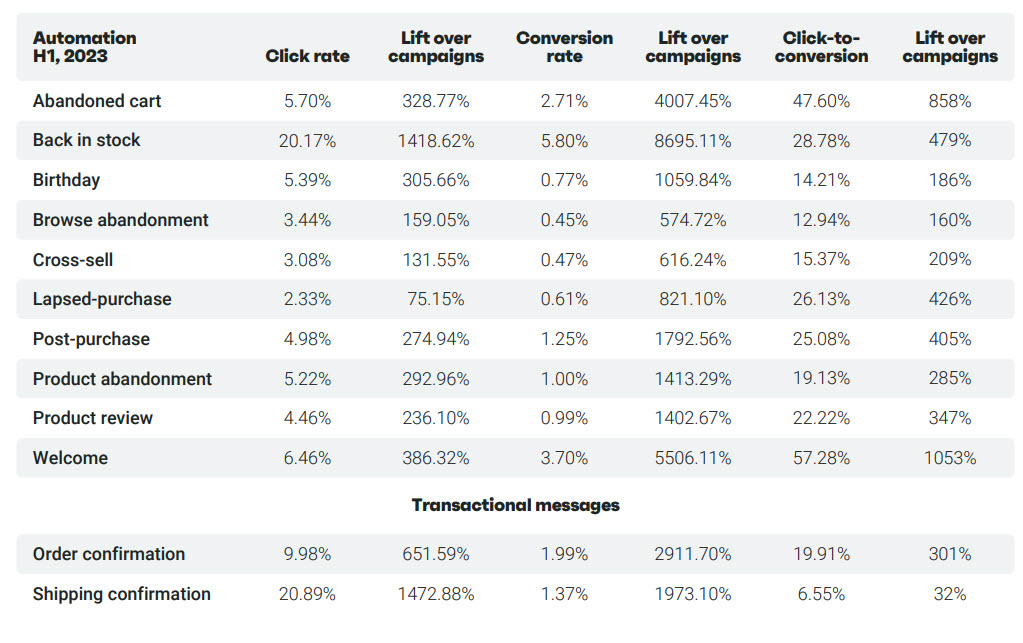
Image via Omnisend
The click rate for post-purchase emails stands at 4.98%. This metric is essential as it measures customer engagement. A high click rate indicates that customers are interested in post-purchase content.
The conversion rate from these emails is 1.25%. This shows the percentage of click-throughs that lead to a subsequent purchase. It’s a clear sign of the efficacy of post-purchase messaging in driving additional sales.
The click-to-conversion rate is notably high, standing at 25.08%. This suggests that a quarter of customers who click on post-purchase emails make another purchase. Such a substantial uplift speaks volumes about the potential of post-purchase emails. They are highly effective in encouraging repeat business.
Post-purchase emails’ lift-over campaign figures are also impressive (274.94%, 1792.56%, and 405%). They demonstrate the added value post-purchase messages contribute compared to other campaign types.
These benchmarks underscore the importance of optimizing post-purchase email strategies. They demonstrate that a post-purchase message is more than just a follow-up. It’s also a powerful tool for driving revenue and enhancing customer loyalty.
Segmenting post-purchase emails
Effective segmentation of post-purchase emails ensures that the right message reaches the right customer. It’s a strategic approach that enhances relevance and personalization. Let’s explore different segmentation options that boosts post-purchase email automation.
By categories
Segmentation by categories allows ecommerce brands to personalize their post-purchase emails. It will allow them to deliver content that resonates with the specific interests and behaviors of different customer groups. Here’s how brands can segment their post-purchase message by various categories:
New and returning customers
For new customers, the initial post-purchase email is a prime opportunity to extend a warm welcome. It should reassure them about their purchase. Additionally, it should introduce them to the brand’s community. This email could also include a brief overview of the brand’s mission and values.
Returning customers, already familiar with the brand, should receive tailored post-purchase messages. These messages should acknowledge their continued support.
The emails can offer advanced tips on product usage. They might also highlight new features that align with their previous purchases. This approach reinforces the value of their loyalty. It also encourages an ongoing relationship.
VIP segment
VIP customers, who spend the most or shop frequently, deserve special attention. Post-purchase emails to this group can include exclusive offers. It could also feature early access to new products or personalized thank-you messages. Recognizing their loyalty via post-purchase communications can further incentivize continued business.
Demographics
Demographic data like age, gender, or location can shape post-purchase messaging. For younger audiences, trendy and engaging content might be more appropriate. Meanwhile, location-based segments may appreciate localized information or region-specific offers. You can also include the closest brick-and-mortar locations in your emails.
For example, if you sell yoga items and yoga centers are among your items’ distribution centers, you can include information about the nearest yoga center based on the recipient’s location.
Website activity
Customers’ website activity provides valuable insights into their interests. This data can be used to make relevant suggestions in post-purchase emails.
For example, consider a customer who often browses a specific category. In such cases, post-purchase emails can include suggestions for related products.
By products
Segmenting a post-purchase email sequence by products purchased allows brands to send specific and relevant messages.
If a customer bought a kitchen item, follow-up emails could include recipes. Alternatively, they could offer maintenance tips.
Product-specific segmentation guarantees that communications add value. It also helps the customer feel confident in their purchase decision.
Five post-purchase message best practices
Crafting post-purchase messages requires critical attention. Done right, they can significantly enhance customer loyalty and foster brand advocacy. Here are five best practices to guarantee your messages resonate and drive results.
1. Personalize post-purchase message best practice
Go beyond just saying “Dear [First Name].” Reference customers’ purchase history and recommend products that complement their purchase.
For example, consider a customer who just purchased a laptop. A post-purchase email to them could include tips on extending battery life. Alternatively, it could offer an invitation to a webinar on productivity hacks.
On the platforms like Mailchimp, Klaviyo or Omnisend, there are dynamic recommendation elements that can be easily added to your emails. Such elements add products relevant to each recipient separately, so you don’t have to think about how to implement these personalization solutions.
2. Aim for clarity
Each post-purchase message should have a clear purpose. It might be to confirm an order, provide shipping details, or offer support. Always start with the most essential information.
For example, an order confirmation message should prominently display the order number. It should also clearly state the expected delivery date. This approach makes the information easy to find, making the email more user-friendly.
3. Share timely and relevant updates
Send a post-purchase message immediately after purchase. Follow with another when the item ships. Then, send a follow-up once the customer has received their order.
Timing your post-purchase messages reassures customers at each step. However, relevance is key. If a product is back-ordered, communicate this proactively, add customer support information. Doing so helps to manage expectations and reduce customer anxiety.
4. Add value to every interaction
Make sure every post-purchase message provides value. If it’s a follow-up email, include a discount on a future purchase. Alternatively, share exclusive content.
For example, after a customer purchases a grill, send them a post-purchase message. This message could include a PDF guide on grilling techniques. Or, it could offer an invitation to an exclusive grilling masterclass. This strategy positions your brand as a valuable resource beyond the initial sale.
5. Encourage dialogue through feedback
Use post-purchase messages to invite customers to provide feedback. But make it easy for them. Include a one-click rating in the email body. Alternatively, you can direct them to a quick survey.
For example, send a post-purchase email after a customer has had time to use their new camera. Ask them to rate their photography experience from 1 to 5.
This approach not only provides you with actionable insights. It also engages the customer and demonstrates your concern for their satisfaction.
13 Post-purchase message examples
At this point, you already understand the immense value that post-purchase messages offer. They reinforce brand trust and enhance customer satisfaction. Now, let’s explore some examples that illustrate how to use them effectively.
1. Order confirmation messages
An order confirmation is the first post-purchase message a customer receives. It sets the tone for customer communication.
These messages should be reassuring and informative, and reflect the brand’s voice. The two examples below illustrate this concept.
Eero’s email thanks the customer and provides clear order details. It does this while maintaining a sleek design. This exemplifies how a post-purchase message can be both informative and aesthetically pleasing.

Image via Really Good Emails
This SMS message confirms the order and provides a link for further details. Its casual tone makes it feel personal. Also, the concise language ensures the message is understood at a glance.
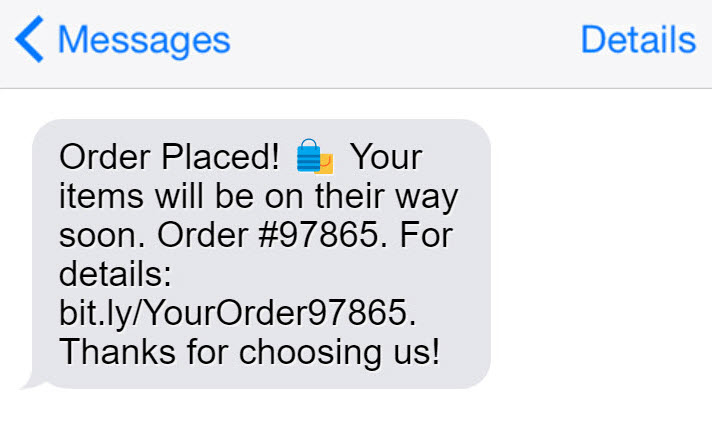
2. Shipping updates
Shipping updates reassure customers about the status of their orders. Effective updates blend timely information with a tone reflecting the brand’s service commitment. The following examples demonstrate this in action.
FOOD52’s shipping update email assures the customer of their shipment’s progress. It also offers a convenient tracking option.
By including an image of the purchased item, the message becomes personalized. This excites the customer about what’s to come.

Image via Really Good Emails
The SMS update below immediately notifies the customer of the dispatch of their package. Additionally, it provides a tracking link and an expected delivery date. The message’s conciseness makes it ideal for customers to understand on the go.
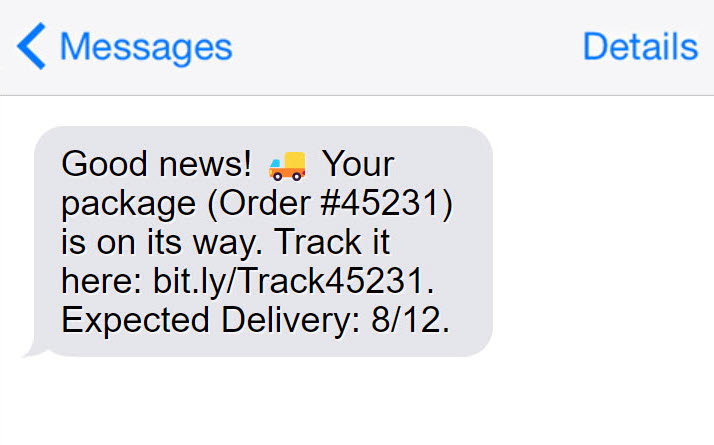
3. Product tips
After a purchase, providing product tips can significantly enhance customer satisfaction. It offers an opportunity to educate and engage customers. Let’s explore how this can be effectively done with two examples.
Allergy Buyers Club uses clear, step-by-step visuals to walk customers through its product’s setup process. This ensures a smooth start for the customer.

Image via Really Good Emails
This SMS message is succinct yet effective. It provides a link to a product guide. This invites the customer to explore the full potential of their purchase.
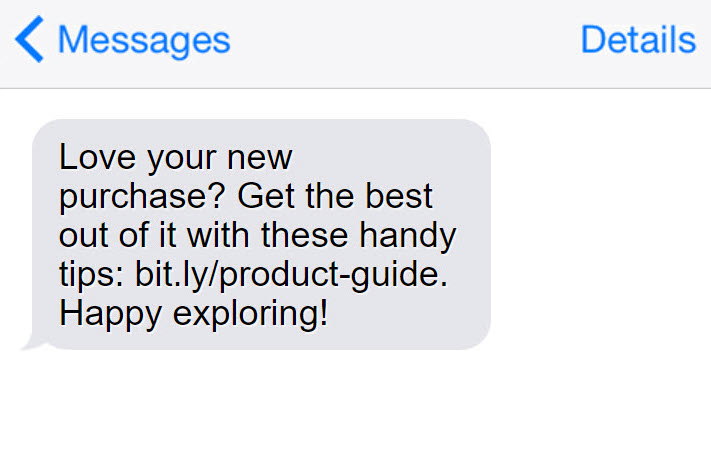
4. Feedback requests
Requesting feedback post-purchase is a strategic move. It engages customers and helps improve future offerings. It’s also an acknowledgment that their opinions are valued. The examples below illustrate how to invite feedback effectively.
GRAZA’s post-purchase email is both visually engaging and functional. It pops with vibrant colors and clearly communicates the email’s intent. Additionally, it includes a prominent call-to-action button that leads to the next step.
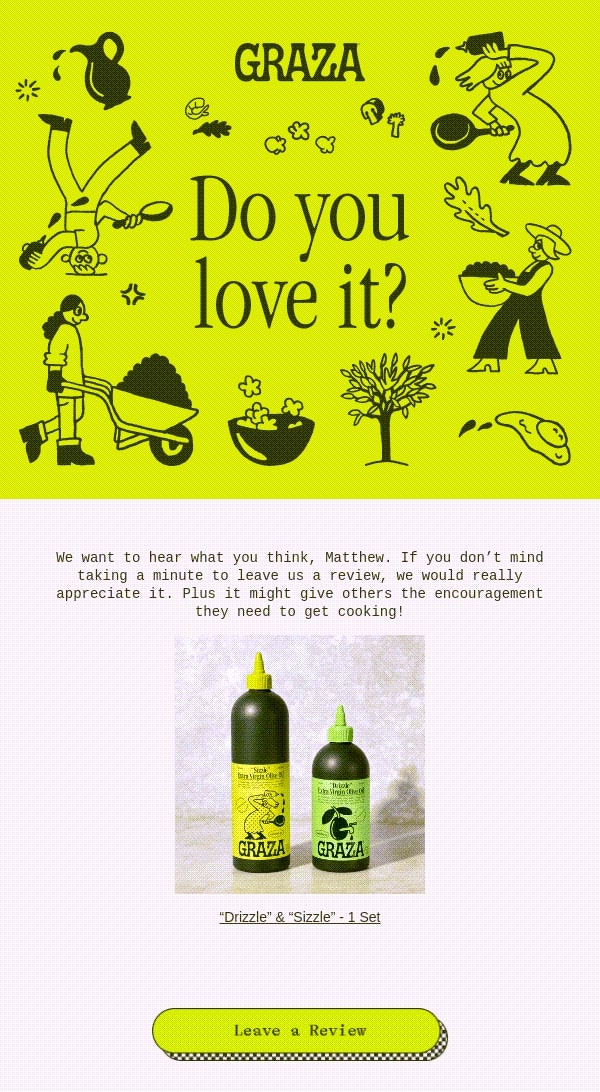
Image via Really Good Emails
This SMS message expresses the importance of the customer’s opinion. It also provides a direct link to a feedback form.
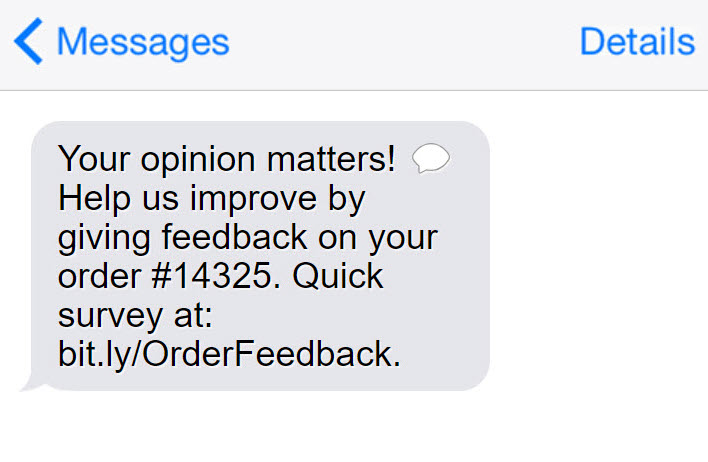
5. Cross-sell and upsell
Post-purchase email campaigns and text messages offer valuable cross-sell and upsell opportunities. Effectively leveraging these can significantly enhance the lifetime value of a customer. Let’s explore how this can be done effectively.
Blume’s email presents additional products as a natural extension of the customer’s initial purchase.
The email features clear, attractive images and easy navigation for shopping. This makes the post-purchase offer feel more like a service than a sales pitch.
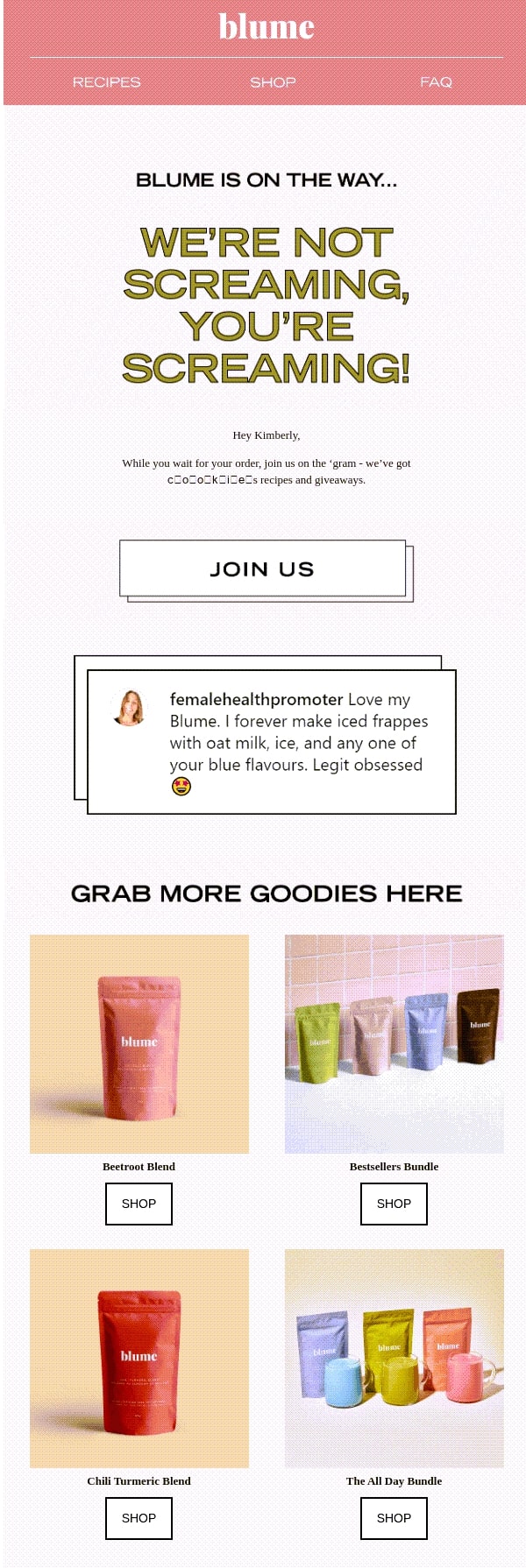
Image via Really Good Emails
This SMS piques interest by suggesting complementary items. The message also makes the next step effortless with a link.
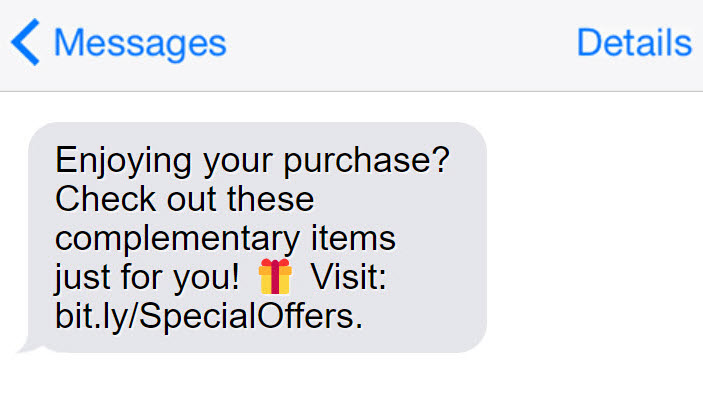
6. Referral request
Referral requests offer a win-win situation in post-purchase communication. They motivate customers to share their positive experiences with friends. This, in turn, expands your brand’s reach. The examples below demonstrate this strategy in action.
Cometeer’s email effectively showcases an exciting referral rewards program. It is eye-catching and persuasive. Additionally, it is crafted in a way that makes it easy for customers to participate and spread the word.

Image via Really Good Emails
This SMS simplifies the referral process to a single tap. It encourages customers to ‘Share the love,’ and provides a direct link to the referral program.
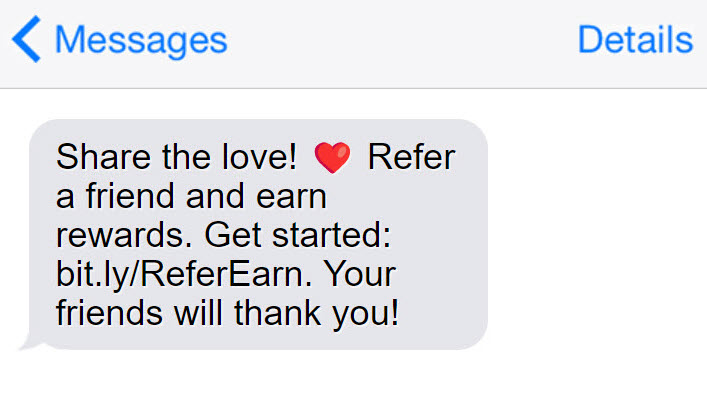
7. User-generated content messages
User-generated content (UGC) messages are a powerful way to showcase real customers’ interactions with your products. They create authenticity and trust in your brand. The example below illustrates how you can harness UGC in your post-purchase messaging.
The email below from Bellroy invites customers to be part of a larger story. The #mybellroy hashtag not only fosters a sense of community but also acts as a call to action. It encourages customers to share their own experiences.
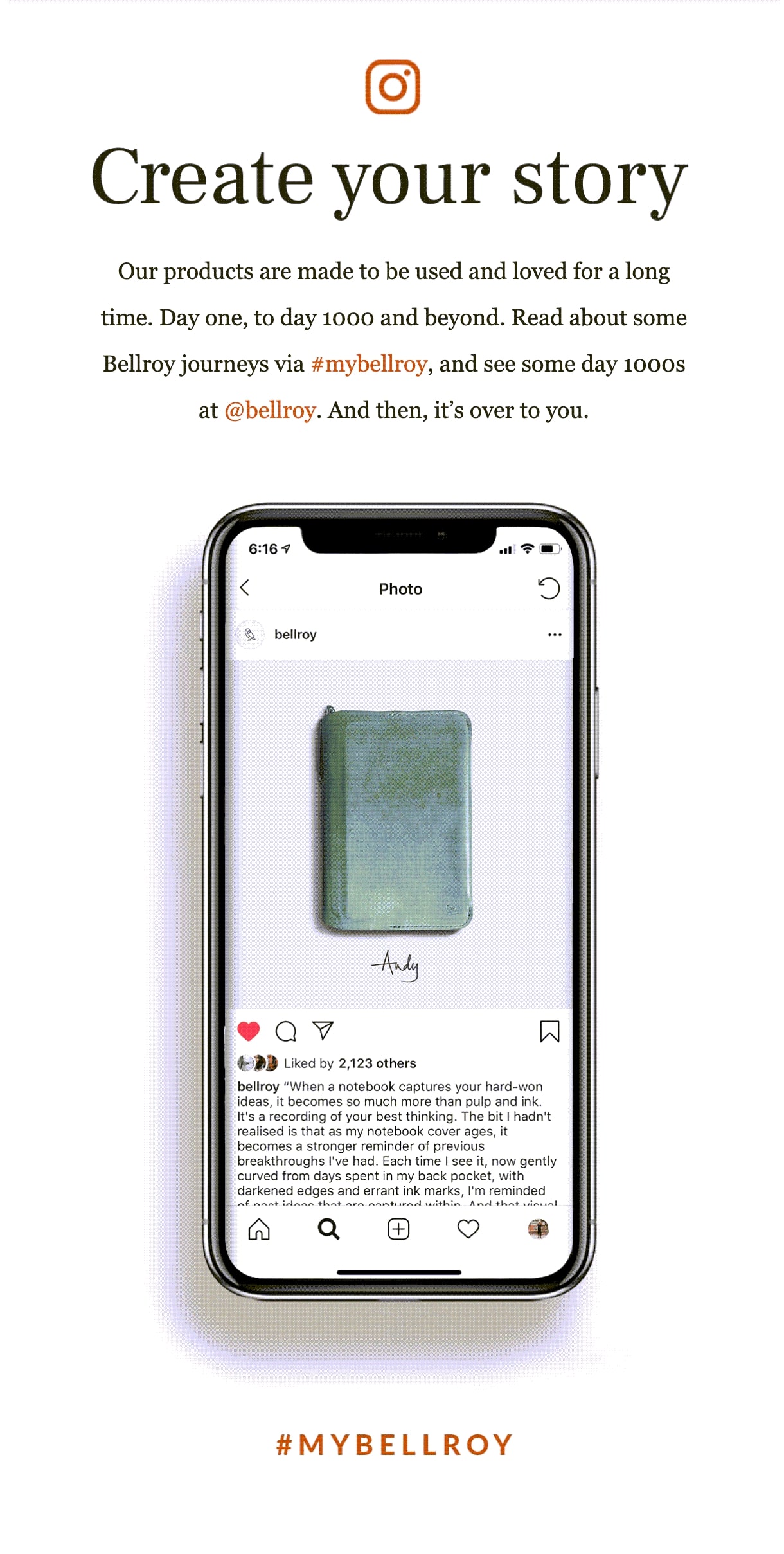
Image via Really Good Email
Post purchase message: Wrap up
Post-purchase messages play a pivotal role in nurturing customer relationships. Beyond serving as transactional touchpoints, they create opportunities to encourage repeat orders and foster brand advocacy. From order confirmations to feedback requests, each message type serves a unique function in the customer journey.
Personalization, timing, value addition, and clarity are key to crafting messages that resonate. Whether through email or SMS, each communication should be thoughtful and intentional.
Remember, the end of a sale is just the beginning of the next opportunity. Keep the conversation going and watch as one-time buyers become lifelong brand advocates.